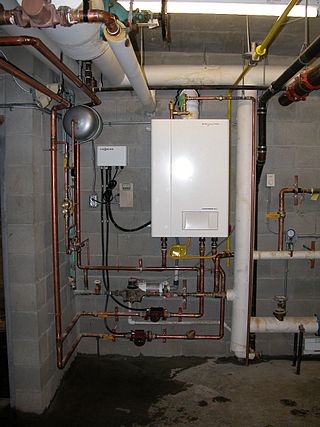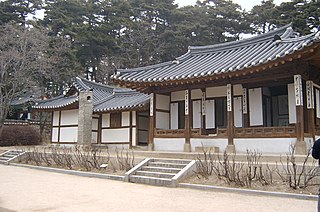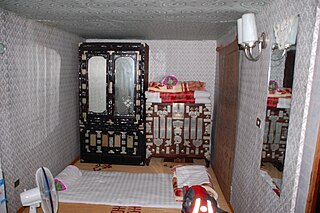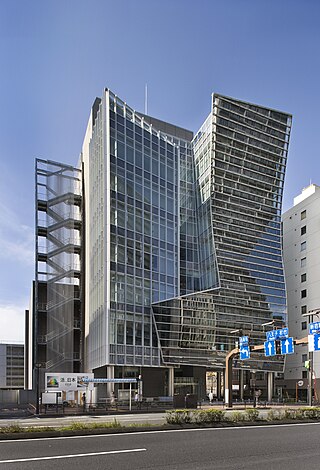
An apartment, flat, or unit is a self-contained housing unit that occupies part of a building, generally on a single storey. There are many names for these overall buildings. The housing tenure of apartments also varies considerably, from large-scale public housing, to owner occupancy within what is legally a condominium, to tenants renting from a private landlord.

A hypocaust is a system of central heating in a building that produces and circulates hot air below the floor of a room, and may also warm the walls with a series of pipes through which the hot air passes. This air can warm the upper floors as well. The word derives from the Ancient Greek hypo meaning "under" and caust-, meaning "burnt". The earliest reference to such a system suggests that the Temple of Ephesus in 350 BC was heated in this manner, although Vitruvius attributes its invention to Sergius Orata in c. 80 BC. Its invention improved the hygiene and living conditions of citizens, and was a forerunner of modern central heating.

A condominium is an ownership regime in which a building is divided into multiple units that are either each separately owned, or owned in common with exclusive rights of occupation by individual owners. These individual units are surrounded by common areas that are jointly owned and managed by the owners of the units. The term can be applied to the building or complex itself, and is sometimes applied to individual units. The term "condominium" is mostly used in the US and Canada, but similar arrangements are used in many other countries under different names.

A household consists of one or more persons who live in the same dwelling. It may be of a single family or another type of person group. The household is the basic unit of analysis in many social, microeconomic and government models, and is important to economics and inheritance.

A central heating system provides warmth to a number of spaces within a building from one main source of heat. It is a component of heating, ventilation, and air conditioning systems, which can both cool and warm interior spaces.

Ondol or gudeul in Korean traditional architecture is underfloor heating that uses direct heat transfer from wood smoke to heat the underside of a thick masonry floor. In modern usage it refers to any type of underfloor heating, or to a hotel or a sleeping room in Korean style.

A kotatsu is a low, wooden table frame covered by a futon, or heavy blanket, upon which a table top sits. Underneath is a heat source, formerly a charcoal brazier but now electric, often built into the table itself. Kotatsu are used almost exclusively in Japan, although similar devices for the same purpose of heating are used elsewhere, e.g. the Spanish brasero or Iranian korsi.
Jeonse, also known as chŏnse, key money deposit or key money, is a type of lease or deposit common in the South Korean real estate market. Instead of paying monthly rent, a renter will make a lump-sum deposit on a rental space, at anywhere from 50% to 80% of the market value, which is then returned at the end of the lease term. The owners make profit from reinvesting the jeonse deposit, instead of receiving the monthly rent. It is also possible to combine a lower jeonse deposit with a small monthly rent; this is known as banjeonse

Housing in Japan includes modern and traditional styles. Two patterns of residences are predominant in contemporary Japan: the single-family detached house and the multiple-unit building, either owned by an individual or corporation and rented as apartments to tenants, or owned by occupants. Additional kinds of housing, especially for unmarried people, include boarding houses, dormitories, and barracks.

Multifamily residential, also known as multidwelling unit (MDU)) is a classification of housing where multiple separate housing units for residential inhabitants are contained within one building or several buildings within one complex. Units can be next to each other (side-by-side units), or stacked on top of each other (top and bottom units). Common forms include apartment building and condominium, where typically the units are owned individually rather than leased from a single building owner. Many intentional communities incorporate multifamily residences, such as in cohousing projects.

A hanok or chosŏnjip, is a traditional Korean house. Hanok were first designed and built in the 14th century during the Joseon dynasty.

The Kaesong Folk Hotel is a tourist hotel located in Kaesong, North Korea, which opened in 1989. Housed in 19 traditional hanok-style courtyard houses, many of which date to the Joseon dynasty and retain their original furnishings. The complex has 50 rooms, a traditional restaurant and a souvenir shop. The houses themselves are located on both sides of the stream that runs through Kaesong, with some located at the foot of Mountain Janam.
In South Korea, an officetel is a multi-purpose building with residential and commercial units. This is a type of studio apartment or studio flat.
Housing in Europe includes modern and traditional styles.

The Tokyo Korean Cultural Center is a Korean Cultural Center in Toshima, Tokyo, Japan. Supported by the Korean Ministry of Culture, this center offers Korean Language classes and promotes Korean culture in Japan through educational, sporting, entertainment, art, and trade events and through the promotion of tourism. The Tokyo Korea Center is one of many Korean Cultural Centers in different countries.

G-Train aka West Gold Train (Korean: 서해금빛열차) is a South Korean tourist train operated by Korail. The train began operations in 2015 and transports tourists from Seoul along the coastal areas of the West Sea.

Heating films are a method of electric resistance heating, providing relatively low temperatures over large areas. Heating films can be directly installed to provide underfloor heating, wall radiant heating and ceiling radiant heating.
Real estate is property consisting of land and the buildings on it, along with its natural resources such as growing crops, minerals or water, and wild animals; immovable property of this nature; an interest vested in this (also) an item of real property, buildings or housing in general. In terms of law, real relates to land property and is different from personal property while estate means the "interest" a person has in that land property.

Choga is a term for traditional Korean houses (hanok) with thatched roofing. The main building materials used to build these houses are straw, wood and soil.
















